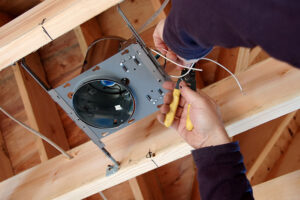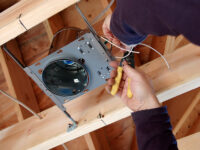The Importance of Energy-Efficient Electrical Installs
An electric circuit is a network of transistors, capacitors, and connecting wires. The circuit may also include a radio or other electronic devices.

Wiring systems are complex. They must follow building codes, power distribution standards, and safety procedures.
A supply cable sets out from your meter and goes into the electrical panel (also called the breaker box). From there, electricity is broken up into different circuits and directed to outlets and switches throughout the building.
An electrical installation is a group of items that are permanently connected to electricity and can receive power from an electricity supplier or generate power themselves. It can also include equipment used to control electricity, such as switches, outlets, and light fixtures.
Residential electrical installations are a key component of any home or apartment building. They can be complicated and dangerous to work on, so it’s important to hire a professional. A qualified electrician can ensure that the wiring is up to code and will not pose a risk of fire or injury.
A residential electrical system starts with the electric service line, which extends from a utility company’s meter into your house. The line is powered by two large wires that connect to screw terminals referred to as “lugs.” The lugs supply electricity to the home’s main service panelboard, or breaker box. From there, individual circuits run throughout the house and power devices like lights, outlets, and appliances.
When installing electrical wiring, it is important to use the right type and size of wire for each job. The wires must be sized according to the amperage and type of appliance, as well as comply with any local codes. It is also common practice to use sheaths that provide insulation and prevent contact with live wires. In addition, it is important to make sure that all wires are protected by conduit or a metal box when running through walls and attics.
It is also a good idea to keep all electrical wires away from water and other liquids. If a wire becomes wet, it can cause a short circuit and potentially lead to an electrical fire. To avoid this, you should always check the wires with a multimeter before touching them. In addition, you should never cut wires shorter than three inches and always use junction boxes in areas where the wires will be exposed.
A properly designed and installed residential electrical system is essential to the safety and comfort of a home. An experienced electrician can create a safe and functional electrical system that meets all local and national requirements. Whether you need to replace your switch plates, install ceiling fans, or update your electrical panel, a professional can help.
Commercial
A commercial electrical installation refers to the electrical systems and equipment used in commercial spaces such as offices, hospitals, malls, schools, distribution centers, and more. These spaces have different electricity requirements and are subject to strict safety regulations. They also require a higher power capacity to support heavy machinery and devices. This type of electrical installation is typically done by professional electricians who have extensive experience in the field.
The first step in a commercial electrical installation is to connect the building to the local power grid. The power company is responsible for transporting electricity from the grid to the commercial space and adjusting it to a proper voltage. This is important to ensure that the building is receiving the correct amount of energy and is not overloading the system.
Once the building is connected to the power grid, the electrical contractor can begin the actual installation process. They will start by setting up general light wiring and then progress to more complicated lighting wiring. Commercial spaces require plenty of sockets for their numerous devices, machines, lifts, and more. These outlets need to be easy to reach so that occupants can plug in their items quickly. Typically, this involves installing convenience outlets that are placed in convenient locations.
It is important to use a commercial electrical installation that adheres to the National Electrical Code (NEC). This code regulates all aspects of an electrical installation and is designed to minimize electrical hazards. For example, the NEC requires that all wires be properly labeled and protected from damage. It also states that any exposed wiring must be properly shielded to protect against tampering and hazards like fires.
During a commercial electrical installation, it is important to hire a licensed and insured contractor. It is also important to look at a contractor’s track record and check for reviews. This will help you choose the best contractor for your project.
Before a construction site begins, it is important to have a temporary power supply installed. This power supply is needed to provide electricity to the construction crew and their tools so that they can work efficiently. This will prevent any power interruptions that could potentially delay the building construction process.
Industrial
Electrical installations in industrial settings are much more complicated than residential or commercial wiring. They need to be able to handle high voltages and power demands. They also need to comply with strict safety codes and regulations. This type of work requires highly specialized knowledge and skills, so it is best to choose an experienced professional for the job.
One of the most common services that industrial electric contractors perform is installing and maintaining wiring systems. These wiring systems are essential for the operation of industrial equipment and machinery. They also support communications and lighting systems. It is important to use quality materials when constructing an industrial electrical system. This is because the quality of the wires and components will determine the safety of the system and ensure that it will work properly.
Another service that industrial electrical contractors offer is studying a facility’s present and future electrical needs. This may include identifying new equipment or recommending changes to existing ones. They also do troubleshooting and inspections to make sure that the electrical system is up to standard. They are also skilled at preparing and updating plans for new construction projects.
In addition to repairing and maintaining existing electrical systems, industrial electric contractors can also install new systems. This can be a difficult task because it is important to consider the current and future power requirements of the facility. For example, if the company is expanding its production capacity, the electrical system will need to be upgraded to accommodate the increased load.
Industrial electrical installations can be dangerous if they are not designed and maintained correctly. It is therefore important to hire qualified electrical contractors for the job. They should follow the recommendations of various norms, such as the NBR-5410, NR10, and NR12. Passage boxes are essential for a safe and efficient electrical installation, and it is important to choose the right ones for the project.
Electrical wires need to be regularly inspected to ensure that they are properly sized and rated for the load that they will be expected to carry. They also need to be well-ground (earthed) to prevent fires and equipment damage. In addition, electrical wiring should be clearly labeled and organized, and junction boxes should be located in accessible locations to make maintenance easier.
Energy Efficiency
As energy consumption continues to rise worldwide, it is important that electrical installations are as efficient as possible. Whether they are new or existing, the use of high-efficiency motors and switches, low-energy lighting, energy compensation devices, and regulation and automation systems can reduce power requirements, which helps conserve energy. This also decreases harmful greenhouse gas emissions, protecting the environment from further degradation.
In addition to reducing power consumption, many energy efficiency projects can help reduce utility bills. This is because households are charged on a per-kilowatt-hour basis, so lowering energy consumption will result in proportionate savings on electricity bills. Energy audits can pinpoint areas of unnecessary energy waste and suggest appropriate actions for your home.
Electrical installations are an important source of energy consumption, accounting for around 40% of global electricity use. With evolving regulations around climate change and carbon emissions, there is a growing interest in increasing the energy efficiency of buildings and their electrical installations. However, there are often barriers to implementing energy-efficient measures, such as the gap between building codes, which are typically geared towards safety and capacity, and voluntary building standards aimed at limiting energy usage and carbon emissions.
Standardization can offer solutions for these obstacles, such as providing definitions and measurements of energy performance, disseminating and promoting energy efficiency technologies, and establishing minimum energy efficiency requirements. However, there are many other barriers, such as asymmetric information and misaligned incentives, that may lead to underinvestment in energy-efficient measures.
One of the main opportunities for improving the energy efficiency of an electrical installation is to improve its metering capabilities and monitoring systems. This will allow you to track the real-time energy consumption of your electrical installation and optimize its design to minimize losses.
Another area where improved energy efficiency can be achieved is in the choice of equipment. For example, selecting an appropriate transformer size can significantly reduce energy consumption by reducing the losses associated with heat generation. Additionally, the use of the barycentre method can improve the energy efficiency of an electrical installation by locating transformers and switchboards so that they are closer to higher energy consumption loads.






